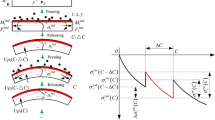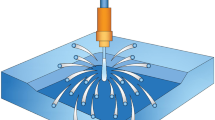Abstract
Shot peening (SP) is widely used in aerospace factories and automotive enterprise for large thin panel forming and strengthening, such as the wing skin panels, spars, and car bonnet. The large panels or sheets are subjected to SP processing, followed by the bending, spanning, and growth (elongation). Precise elongation calculation is a promising and challenging task. This work which includes the mathematical model finite element method (FEM) simulation for predicting the 7050-T7451 aluminum alloy strip elongation with respect to special SP parameters is presented to analyze the potential effects, which was also validated by experiments. As to the integral wing spars, the rolling direction orientations with regard to the rolled spar blank have different effect on elongation after the SP strengthening and shaping. The compressive stress induced by SP will break the original residual stress equilibrium state after rolling. Both experiments and explicit-implicit model predictions showed that the tensile residual stress induced by rolling contributes to the elongation. On the contrary, the compressive residual stress prevents the strip from elongation. Furthermore, the initial residual stress effect is negligible when the thickness is large (above 6-mm thickness). Considering the 7050-T7451 aluminum alloy coefficient of thermal expansion is high, therefore, the temperature is an important factor for the long length spar. In addition, we found the elongation was inversely proportional to thickness and independent of section dimension. The numerical results showed that the elongation was more sensitive to the shot number (coverage) than impact velocity, which was explained based on the newly proposed mathematical model.
Similar content being viewed by others
References
Miková K, Bagherifard S, Bokuvka O, Guagliano M, Trško L (2013) Fatigue behavior of X70 microalloyed steel after severe shot peening. Int J Fatigue 55(5):33–42
Homer SE, Luchene RDV (1991) Aircraft wing skin contouring by shot peening. J Mater Shap Technol 9(2):89–101
Akyıldız HK, Kulekci MK, Esme U (2015) Influence of shot peening parameters on high-cycle fatigue strength of steel produced by powder metallurgy process. Fatigue Fract Eng Mater Struct 38(10):1246–1254
Baughman DL (1984) An overview of peen forming technology. In: Proceedings of the 2nd International Conference on Shot Peening (IL, USA):pp. 28–33
Kopp R, Ball HW (1987) Recent developments in shot peen forming. In: Proceedings of the 3rd international conference on shot peening, pp 297–308
Tatton RJD (1986) Shot peen-forming. In: Impact surface treatment. Bedford, England, pp 134–143
Jiang Z, Liu Y, Li L, Shao W (2014) A novel prediction model for thin plate deflections considering milling residual stresses. Int J Adv Manuf Technol 74(1):37–45
Kulkarni KM, Schey JA, Badger DV (1981) Investigation of shot peening as a forming process for aircraft wing skins. J Appl Metalwork 1(4):34–44
Miao HY, Demers D, Larose S, Perron C, Lévesque M (2010) Experimental study of shot peening and stress peen forming. J Mater Process Technol 210(15):2089–2102
Wang T, Platts MJ, Levers A (2006) A process model for shot peen forming. J Mater Process Technol 172(2):159–162
Seddik R, Bahloul A, Atig A, Fathallah R (2016) A simple methodology to optimize shot-peening process parameters using finite element simulations. Int J Adv Manuf Technol:1–17
Kulekci MK, Esme U (2014) Critical analysis of processes and apparatus for industrial surface peening technologies. Int J Adv Manuf Technol 74(9–12):1551–1565
Zhang XJ, Wang JB, Wang YJ, Qiao MJ (2006) Prediction of shot peen forming parameters of integral aircraft wing panels. Mater Sci Forum 532-533:937–940
Luo KY, Liu B, Wu LJ, Yan Z, Lu JZ (2016) Tensile properties, residual stress distribution and grain arrangement as a function of sheet thickness of Mg-Al-Mn alloy subjected to two-sided and simultaneous LSP impacts. Appl Surf Sci 369:366–376
Yao CF, Dou XT, Wu D, Zhou Z, Zhang JY (2016) Surface integrity and fatigue analysis of shot-peening for 7055 aluminum alloy under different high-speed milling conditions. Adv Mech Eng 8(10):1–10
Takeuti Y, Newko H, Yamakawa S (1971) Temperature dependence of elastic moduli of aluminium alloy and several steel by use of the resonant frequency method. J Soc Mater Sci, JPN 20(214):824–826
Burzic B, Hofele M, Murdter S, Riegel H (2017) Laser polishing of ground aluminum surfaces with high energy continuous wave laser. J Laser Appl 29(1):011701. https://doi.org/10.2351/1.4966923
Al-Hassani STS (1981) Mechanical aspects of residual stress development in shot peening. In: Proceedings of the 1st International Conference on Shot Peening, pp 583–602
Vanluchene RD, Johnson J, Carpenter RG (1995) Induced stress relationships for wing skin forming by shot peening. J Mater Eng Perform 4(3):283–290
Homer SE (1989) Aircraft wing skin contouring as a result of residual stress distributions induced by shot peening. Dissertation, Montana State University
Prime MB, Hill MR (2002) Residual stress, stress relief, and inhomogeneity in aluminum plate. Scr Mater 46(1):77–82
Gariépy A, Larose S, Perron C, Bocher P, Lévesque M (2013) On the effect of the orientation of sheet rolling direction in shot peen forming. J Mater Process Technol 213(6):926–938
Gariépy A, Larose S, Perron C, Lévesque M (2011) Shot peening and peen forming finite element modelling—towards a quantitative method. Int J Solids Struct 48(20):2859–2877
Tian JW, Shaw L, Liaw PK, Dai K (2008) On the ductility of a surface severely plastically deformed nickel alloy. Mater Sci Eng A 498(1–2):216–224
Cao W, Fathallah R, Castex L (1995) Correlation of Almen arc height with residual stresses in shot peening process. Mater Sci Technol 11(9):967–973
Mylonas GI, Labeas G (2011) Numerical modelling of shot peening process and corresponding products: residual stress, surface roughness and cold work prediction. Surf Coat Technol 205(19):4480–4494
Zimmermann M, Schulze V, Hoffmeister J (2013) Finite element modelling of coverage effects during shot peening of IN718. Int J Mater Res 101(8):951–962
Miao HY, Larose S, Perron C, Lévesque M (2009) On the potential applications of a 3D random finite element model for the simulation of shot peening. Adv Eng Softw 40(10):1023–1038
Meguid SA, Shagal G, Stranart JC (2002) 3D FE analysis of peening of strain-rate sensitive materials using multiple impingement model. Int J Impact Eng 27(2):119–134
Acknowledgements
The authors are grateful to the National Natural Science Foundation of China (Grant Nos. 51175257 and 51705248) for the financial support. The work reported in this paper was also supported by the Funding of Jiangsu Innovation Program for Graduate Education (Grant No. KYLX16_0319) and the Fundamental Research Funds for the Central Universities.
Funding
This study was funded by the National Natural Science Foundation of China (Grant Nos. 51175257 and 51705248) and Funding of Jiangsu Innovation Program for Graduate Education (Grant No. KYLX16_0319).
Author information
Authors and Affiliations
Corresponding author
Ethics declarations
Conflict of interest
The authors declare that they have no conflict of interest.
Rights and permissions
About this article
Cite this article
Zhang, J., Lu, S., Zhang, T. et al. An analytical model to study of potential effects on component elongation in shot peening. Int J Adv Manuf Technol 97, 3299–3310 (2018). https://doi.org/10.1007/s00170-018-2201-9
Received:
Accepted:
Published:
Issue Date:
DOI: https://doi.org/10.1007/s00170-018-2201-9




